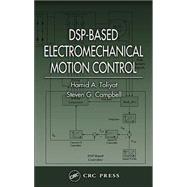
Note: Supplemental materials are not guaranteed with Rental or Used book purchases.
Purchase Benefits
What is included with this book?
| Chapter 1 Introduction to the TMSLF2407 DSP Controller | 1 | (18) | |||
|
1 | (2) | |||
|
3 | (2) | |||
|
5 | (1) | |||
|
6 | (13) | |||
| Chapter 2 C2xx DSP CPU and Instruction Set | 19 | (30) | |||
|
19 | (1) | |||
|
19 | (2) | |||
|
21 | (1) | |||
|
22 | (4) | |||
|
26 | (5) | |||
|
31 | (5) | |||
|
36 | (13) | |||
| Chapter 3 General Purpose Input/Output (GPIO) Functionality | 49 | (12) | |||
|
49 | (1) | |||
|
50 | (7) | |||
|
57 | (1) | |||
|
58 | (3) | |||
| Chapter 4 Interrupts on the TMS320LF2407 | 61 | (16) | |||
|
61 | (1) | |||
|
61 | (3) | |||
|
64 | (6) | |||
|
70 | (7) | |||
|
|||||
| Chapter 5 The Analog-to-Digital Converter (ADC) | 77 | (24) | |||
|
77 | (1) | |||
|
78 | (20) | |||
|
98 | (3) | |||
| Chapter 6 The Event Managers (EVA, EVB) | 101 | (62) | |||
|
101 | (1) | |||
|
102 | (13) | |||
|
115 | (19) | |||
|
134 | (13) | |||
|
147 | (11) | |||
|
158 | (3) | |||
|
161 | (2) | |||
| Chapter 7 DSP-Based Implementation of DC-DC Buck-Boost Converters | 163 | (20) | |||
|
163 | (1) | |||
|
163 | (1) | |||
|
164 | (1) | |||
|
165 | (1) | |||
|
165 | (3) | |||
|
168 | (3) | |||
|
171 | (2) | |||
|
173 | (2) | |||
|
175 | (4) | |||
|
179 | (4) | |||
| Chapter 8 DSP-Based Control of Stepper Motors | 183 | (10) | |||
|
183 | (1) | |||
|
183 | (1) | |||
|
184 | (4) | |||
|
188 | (2) | |||
|
190 | (1) | |||
|
191 | (1) | |||
|
192 | (1) | |||
| Chapter 9 DSP-Based Control of Permanent Magnet Brushless DC Machines | 193 | (16) | |||
|
193 | (2) | |||
|
195 | (1) | |||
|
195 | (1) | |||
|
196 | (4) | |||
|
200 | (9) | |||
| Chapter 10 Clarke's and Park's Transformations | 209 | (14) | |||
|
209 | (1) | |||
|
209 | (1) | |||
|
210 | (2) | |||
|
212 | (1) | |||
|
213 | (1) | |||
|
214 | (8) | |||
|
222 | (1) | |||
|
222 | (1) | |||
| Chapter 11 Space Vector Pulse Width Modulation | 223 | (18) | |||
|
223 | (1) | |||
|
223 | (1) | |||
|
224 | (8) | |||
|
232 | (8) | |||
|
240 | (1) | |||
| Chapter 12 DSP-Based Control of Permanent Magnet Synchronous Machines | 241 | (14) | |||
|
241 | (1) | |||
|
241 | (3) | |||
|
244 | (4) | |||
|
248 | (7) | |||
| Chapter 13 DSP-Based Vector Control of Induction Motors | 255 | (34) | |||
|
255 | (1) | |||
|
255 | (2) | |||
|
257 | (2) | |||
|
259 | (1) | |||
|
260 | (1) | |||
|
261 | (1) | |||
|
262 | (1) | |||
|
262 | (4) | |||
|
266 | (1) | |||
|
266 | (2) | |||
|
268 | (2) | |||
|
270 | (17) | |||
|
287 | (1) | |||
|
288 | (1) | |||
|
288 | (1) | |||
| Chapter 14 DSP-Based Control OF Switched Reluctance Motor Drives | 289 | (18) | |||
|
289 | (1) | |||
|
290 | (2) | |||
|
292 | (1) | |||
|
293 | (8) | |||
|
301 | (3) | |||
|
304 | (1) | |||
|
305 | (1) | |||
|
305 | (2) | |||
| Chapter 15 DSP-Based Control of Matrix Converters | 307 | (20) | |||
|
307 | (1) | |||
|
308 | (1) | |||
|
309 | (5) | |||
|
314 | (5) | |||
|
319 | (1) | |||
|
320 | (1) | |||
|
321 | (1) | |||
|
322 | (3) | |||
|
325 | (2) | |||
| Appendix A Development of Field-Oriented Control Induction Motor Using VisSimTM | 327 | (16) | |||
|
327 | (1) | |||
|
327 | (2) | |||
|
329 | (12) | |||
|
341 | (1) | |||
|
342 | (1) | |||
| Index | 343 |
The New copy of this book will include any supplemental materials advertised. Please check the title of the book to determine if it should include any access cards, study guides, lab manuals, CDs, etc.
The Used, Rental and eBook copies of this book are not guaranteed to include any supplemental materials. Typically, only the book itself is included. This is true even if the title states it includes any access cards, study guides, lab manuals, CDs, etc.